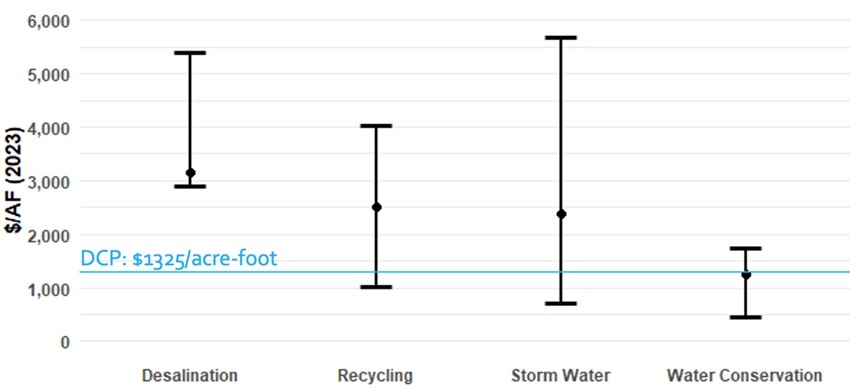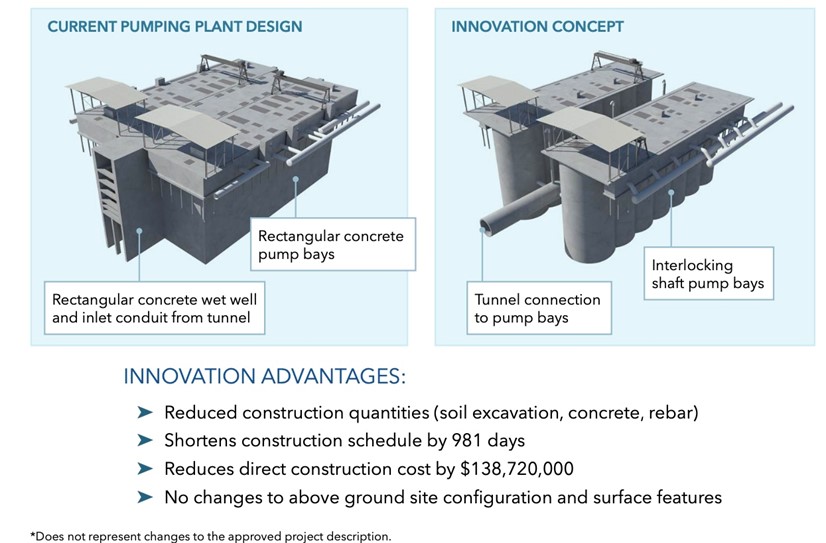A drone view of the Bethany Reservoir, impounded by five dams in Alameda County, serves as a forebay for the South Bay Pumping Plant and afterbay for Banks Pumping Plant.
The project will deliver nearly $38 billion in benefits, preventing both water shortages and water rationing, and saving more water during wet years
SACRAMENTO – Today, the Department of Water Resources (DWR) released a benefit-cost analysis for the Delta Conveyance Project that finds the infrastructure modernization project would create billions of dollars in benefits for California communities, including reliable water supplies, climate change adaptation, earthquake preparedness and improved water quality.
For every $1 spent, $2.20 in benefits would be generated. The report also shows the very real cost of doing nothing, posing significant future challenges to supplying water to California communities.
“The Delta Conveyance Project passes the benefit-cost test readily, with benefits that are more than double the cost,” said Dr. David Sunding, Emeritus Professor, UC Berkeley, who led the benefit-cost analysis. “The project enables ongoing demands to be satisfied and water supply reliability to be maintained,” he said, adding “the benefits clearly justify the costs.”
As climate change and regulatory constraints cause water supplies to diminish over time, the reliability of the State Water Project infrastructure is in jeopardy, putting 27 million Californians and 750,000 acres of farmland at risk. This new benefit-cost analysis provides a compelling financial rationale for the public water agencies funding the project to be able continue to provide affordable, safe, clean and reliable water supply.
“Twenty-seven million people rely on these surface water supplies that support a $2.3 trillion economy in California.” said Karla Nemeth, Director of the California Department of Water Resources. “There is a very real cost to do nothing. It is vastly more efficient and economical to avoid declining supplies. Water shortages, mandatory restrictions, land fallowing and job loss all impact our state and local economies.
Figure: Delta Conveyance Project water supplies among most economical sources

MORE WATER SUPPLY
The need for operational flexibility that the Delta Conveyance Project would grant water managers is especially notable this year. Even though it was a wet winter, fishery-related regulations significantly constrained water exports from the south Delta. If the Delta Conveyance Project had been available, an additional 909,000 acre-feet of water could have been moved from the intakes in the north Delta where it is safer for fish. The Delta Conveyance Project helps resolve these difficult conflicts in the south Delta.

COSTS REMAIN FLAT, DESIGN Innovations CAN SAVE ANOTHER $1.2B
An updated cost estimate was prepared by the Delta Conveyance Design and Construction Authority (DCA). The cost of the project is estimated to be $20.1B in real 2023 (undiscounted) dollars. A preliminary cost assessment conducted in 2020, early in the design process, showed the project would cost about $16B. Accounting for inflation to 2023 dollars shows that the two estimates are similar in cost. Even as details are added and refinements made to the program, costs are holding steady.
The DCA is the joint powers authority that, under DWR’s direction, is responsible for project design and engineering and will oversee construction. The DCA is a public agency comprised of the local public water agencies participating in the project.
“Our member agencies are paying for this project, and they have a fiduciary responsibility to their ratepayers to ensure the project is built on time and budget with the highest industry standards for safety, quality and risk management,” said Graham Bradner, executive director of the DCA.
The DCA conducted a preliminary value engineering exercise to identify design and construction innovations that present opportunities to cut costs, save time, and reduce risks. These engineering innovations, while not representing changes to the approved project description, do show that there is genuine potential for a significant cost reduction of about $1.2 billion even at this early stage of project development.
Some examples of the DCA’s recommended design and construction innovations include:
- Optimize the Bethany Reservoir Pumping Plant belowground configuration to reduce construction effort and house the pumping plant equipment and piping more efficiently.
- Consider the latest tunnel boring machine technology that allows excavation and lining installation to happen concurrently.
- Raise the elevation of the intake screens to create more separation from the river bottom, improving O&M and reducing the depth of the intake structure.

$200 Million Set Aside for Local Delta Community Projects
A number that is new and noteworthy is the $200 million set-aside for the project’s Community Benefits Program. DWR committed to this program by including it in the project’s environmental impact report, and this is the first time identifying a dollar value.
“We are committed to bringing substantial and tangible benefits to the communities in the project area that will see the most impacts from construction,” said Carrie Buckman, DWR’s Environmental Program Manager for the Delta Conveyance Project.
The Community Benefits Program is a recognition that while the benefits of the project are in other parts of California, the construction effects are local. While DWR remains committed to all mitigation adopted to address local environmental impacts, the Community Benefits Program will provide a grant fund for local projects, in addition to business development set-asides for job training and local business utilization, and potential “leave-behinds” like broadband or other infrastructure.
“The Community Benefits Program is going to pick up steam,” Buckman said. “We would like to work with communities to identify their priority projects and earmark those funds.”
Later this year, a draft implementation plan will be published for community review and input. It will include details about funding criteria and program administration.
RESOURCES:
- Benefit Cost Analysis
- Cost Estimate
- Facts About the Economic Value of the Delta Conveyance Project
- FAQ: Understanding Costs, Benefits, Funding and Financing for the Delta Conveyance Project
###
Contact:
Public Affairs, Department of Water Resources
